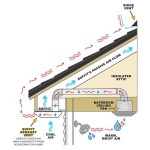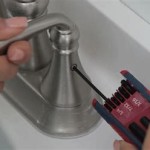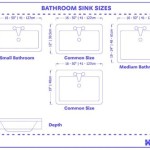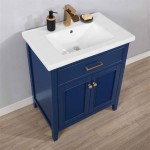What Is The Standard Size of a Bathroom Faucet?
Determining the standard size of a bathroom faucet is not as straightforward as identifying a single, universally accepted measurement. The perception of "standard" is influenced by several factors, including faucet type, mounting configuration, and regional plumbing codes. Instead of a single size, a range of dimensions exists, with considerations given to compatibility with standard sink configurations and ensuring comfortable usability. This article delves into the nuances of bathroom faucet sizing, examining the key aspects that homeowners and plumbers need to understand.
The term "standard size" often refers to the compatibility of a faucet with pre-drilled holes in a bathroom sink or countertop. Most sinks are manufactured with either a single hole, a center-set (three-hole with 4-inch spread), or a widespread (three-hole with 8-16 inch spread) configuration. The faucet's dimensions, particularly the base and spout reach, must align with these pre-existing hole patterns to ensure a proper fit. Ignoring these dimensions can lead to installation difficulties, water leakage, or an aesthetically displeasing result.
It’s important to note that “standard” does not imply a limitation in design choices. Numerous faucet styles, from minimalist single-handle faucets to elaborate bridge faucets, are available within the parameters of standard hole configurations. Understanding the standard hole configurations and how faucet dimensions relate to them is crucial for selecting a faucet that is both functional and visually appealing.
Beyond hole configuration, the height and spout reach of a faucet also play a significant role in determining its suitability for a particular sink. A faucet that is too short might not allow for comfortable handwashing, while one that is too tall could cause splashing. Similarly, a spout reach that is too short will result in water hitting the back of the sink, while an excessively long reach might cause water to splash over the front edge. The ideal faucet size is a balance between aesthetic preference and ergonomic functionality, tailored to the specific dimensions of the sink being used.
Understanding Sink Hole Configurations
The number and spacing of holes drilled into a bathroom sink or countertop are critical determinants of faucet compatibility. Three primary configurations exist: single-hole, center-set, and widespread. Each configuration necessitates a specific type of faucet designed to align with the existing plumbing connections and mounting points.
Single-hole faucets are designed for sinks with only one pre-drilled hole. These faucets typically feature a single handle that controls both water temperature and flow. The base of a single-hole faucet is usually relatively small to accommodate the limited mounting space. Single-hole configurations offer a clean and modern aesthetic, simplifying the installation process and minimizing clutter around the sink.
Center-set faucets are designed for sinks with three holes, spaced 4 inches apart. These faucets often feature a combined base that houses both the spout and the two handles for hot and cold water control. Center-set faucets are a common choice for smaller bathrooms where space is limited. The 4-inch spread is a standard dimension, ensuring that most center-set faucets are compatible with a wide range of sinks designed for this configuration.
Widespread faucets are also designed for sinks with three holes but feature a much wider spacing, typically ranging from 8 to 16 inches. Unlike center-set faucets, widespread faucets have separate bases for the spout and the two handles, allowing for greater design flexibility. This configuration is often preferred in larger bathrooms where a more visually expansive and luxurious aesthetic is desired. The adjustable spread of widespread faucets offers some flexibility in installation, but it is essential to ensure that the selected faucet is compatible with the specific hole spacing of the sink.
In cases where a sink has more holes than the chosen faucet requires, escutcheon plates can be used to cover the unused holes. These plates provide a clean and finished look, preventing water from splashing into the open holes and maintaining the overall aesthetic integrity of the bathroom.
Key Faucet Dimensions: Height and Spout Reach
Beyond the hole configuration, the height and spout reach are pivotal dimensions that affect the usability and aesthetic appeal of a bathroom faucet. These dimensions must be carefully considered in relation to the sink's size and shape to ensure a comfortable and functional experience.
Faucet height refers to the vertical distance from the base of the faucet to the highest point of the spout. The ideal faucet height depends on the type of sink being used. For vessel sinks, which sit above the countertop, a taller faucet is necessary to provide adequate clearance for handwashing. Standard undermount or drop-in sinks typically require shorter faucets to prevent excessive splashing. A faucet that is too short might make it difficult to wash hands comfortably, while one that is too tall can create an unappealing visual imbalance and lead to water splashing outside the sink.
Spout reach refers to the horizontal distance from the base of the faucet to the point where the water stream exits the spout. The spout reach should be sufficient to direct the water stream towards the center of the sink basin. If the spout reach is too short, the water will hit the back of the sink, potentially causing splashing and discomfort. If the spout reach is too long, the water may splash over the front edge of the sink, leading to water damage and an unpleasant user experience. A well-chosen spout reach ensures that the water stream is properly positioned for comfortable and efficient handwashing.
When selecting a faucet, it is advisable to measure the depth of the sink from the faucet mounting hole to the front edge of the sink. The spout reach should be approximately half of this measurement to ensure that the water stream lands in the center of the basin. It is also important to consider the angle of the water stream, as this can affect the overall reach and prevent unwanted splashing.
Some faucets offer adjustable spout reach or height, providing greater flexibility in installation and allowing for customization to suit individual preferences. These adjustable faucets can be particularly useful in situations where the sink dimensions are not perfectly standard or where multiple users with different needs will be using the sink.
Understanding Rough-In Dimensions and Plumbing Connections
The "rough-in" dimensions refer to the location of the water supply lines and drainpipe behind the wall or under the sink. These dimensions are critical for ensuring that the faucet can be properly connected to the existing plumbing infrastructure. Understanding the rough-in dimensions is essential for both new construction and remodeling projects.
The standard rough-in height for water supply lines is typically around 22 to 24 inches above the finished floor. This height allows for easy access to the shut-off valves located beneath the sink. The drainpipe is typically located around 18 to 20 inches above the finished floor. These dimensions can vary slightly depending on local plumbing codes and the specific design of the bathroom.
The faucet's supply lines connect to the shut-off valves, which control the flow of hot and cold water to the faucet. These supply lines are typically flexible hoses made of stainless steel or braided polymer, making them easy to connect and adjust. It is important to ensure that the supply lines are long enough to reach the shut-off valves without being stretched or strained.
The drainpipe connects to the faucet's drain assembly, which includes the drain stopper and the tailpiece. The drain assembly must be properly sealed to prevent water leakage. Plumbers typically use plumber's putty or Teflon tape to create a watertight seal between the drain assembly and the sink.
Understanding the rough-in dimensions and plumbing connections is crucial for a successful faucet installation. Consulting with a qualified plumber is recommended, especially for complex installations or when dealing with older plumbing systems. A plumber can ensure that the faucet is properly connected and that all plumbing connections are secure and leak-free.
In summary, the "standard size" of a bathroom faucet is not a singular measurement, but rather a consideration of several factors including hole configuration, faucet height, spout reach, and rough-in dimensions. Careful attention to these details will result in a faucet that is both aesthetically pleasing and functionally appropriate for the specific sink and bathroom environment. Prioritizing careful measurement and considering existing plumbing infrastructure will contribute to a successful and satisfying faucet installation.

Standard Bathroom Sink Dimensions With Photos Upgradedhome Com

Standard Height Of Bathroom Fittings Fantasticeng

Standard Bathroom Sink Dimensions With Photos Upgradedhome Com

American Standard Size Sanitary Ware Bathroom Sink White Wash Basin Solid Surface Washing Vanity China Art Made In Com

Standard Bathroom Sink Dimensions With Photos Upgradedhome Com

Ruvati 16 X 11 Inch Brushed Stainless Steel Rectangular Bathroom Sink Undermount Rvh6107 Usa

What S The Standard Depth Of A Bathroom Vanity

Standard Bathroom Sink Dimensions With Photos Upgradedhome Com

American Standard Decorum Vitreous China Wall Hung Rectangle Vessel Sink With 8 In Widespread Faucet Holes White 9134008ec 020 The Home Depot

What Is Standard Size Hole For A Kitchen Or Bathroom Faucet






